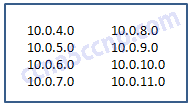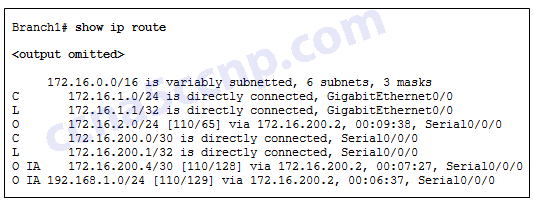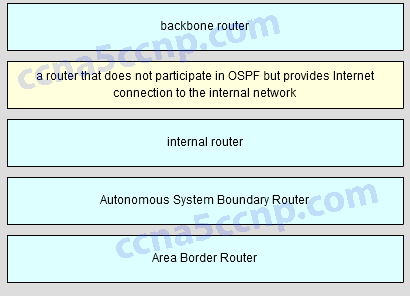Last Updated on April 24, 2018 by Admin
CCNA3 Chapter 6 Exam Answer v5.03 2016
From year to year, Cisco has updated many versions with difference questions. The latest version is version 6.0 in 2018. What is your version? It depends on your instructor creating your class. We recommend you to go thought all version if you are not clear. While you take online test with netacad.com, You may get random questions from all version. Each version have 1 to 10 different questions or more. After you review all questions, You should practice with our online test system by go to "Online Test" link below.
| Version 5.02 | Version 5.03 | Version 6.0 | Online Assessment |
| Chapter 6 Exam | Chapter 6 Exam | Chapter 6 Exam | Online Test |
| Next Chapter | |||
| Chapter 7 Exam | Chapter 7 Exam | Chapter 7 Exam | Online Test |
| Lab Activities | |||
| 6.2.2.4 Packet Tracer – Configuring Basic EIGRP with IPv4 | |||
| 6.3.4.4 Packet Tracer – Investigating DUAL FSM | |||
| 6.4.3.4 Packet Tracer – Configuring Basic EIGRP with IPv6 Routing | |||
-
Why do OSPF serial interfaces usually require manual bandwidth configuration?
- OSPF uses the bandwidth value to compute routes for its routing table.
- Each side of an OSPF serial link should be configured with a unique value.
- All serial interfaces default to a value of 1.544 Mb/s.
- Bandwidth value affects the actual speed of the link.
-
Which statement describes a multiarea OSPF network?
- It consists of multiple network areas that are daisy-chained together.
- It requires a three-layer hierarchical network design approach.
- It has a core backbone area with other areas connected to the backbone area.
- It has multiple routers that run multiple routing protocols simultaneously, and each protocol consists of an area.
-
What is one advantage of using multiarea OSPF?
- It allows OSPFv2 and OSPFv3 to be running together.
- It enables multiple routing protocols to be running in a large network.
- It increases the routing performance by dividing the neighbor table into separate smaller ones.
- It improves the routing efficiency by reducing the routing table and link-state update overhead.
-
Which characteristic describes both ABRs and ASBRs that are implemented in a multiarea OSPF network?
- They usually have many local networks attached.
- They both run multiple routing protocols simultaneously.
- They are required to perform any summarization or redistribution tasks.
- They are required to reload frequently and quickly in order to update the LSDB.
-
What is used to facilitate hierarchical routing in OSPF?
- autosummarization
- the use of multiple areas
- frequent SPF calculations
- the election of designated routers
-
Which two statements correctly describe OSPF type 3 LSAs? (Choose two.)
- Type 3 LSAs are known as autonomous system external LSA entries.
- Type 3 LSAs are generated without requiring a full SPF calculation.
- Type 3 LSAs are used for routes to networks outside the OSPF autonomous system.
- Type 3 LSAs are known as router link entries.
- Type 3 LSAs are used to update routes between OSPF areas.
-
What OSPF LSA type is used to inform routers of the router ID of the DR in each multiaccess network in an OSPF area?
- type 1
- type 2
- type 3
- type 4
-
What type of OSPF LSA is originated by ASBR routers to advertise external routes?
- type 1
- type 2
- type 3
- type 5
-
Refer to the exhibit. What can be concluded about network 192.168.4.0 in the R2 routing table?
- The network was learned from a router within the same area as R2.
- The network was learned through summary LSAs from an ABR.
- The network can be reached through the GigabitEthernet0/0 interface.
- This network should be used to forward traffic toward external networks.
-
What routing table descriptor is used to identify OSPF summary networks that originate from an ABR?
- O
- O IA
- O E1
- O E2
-
Which three steps in the design and implementation of a multiarea OSPF network are considered planning steps? (Choose three.)
- Verify OSPF.
- Configure OSPF.
- Define the OSPF parameters.
- Gather the required parameters.
- Troubleshoot the configurations.
- Define the network requirements.
-
A network administrator is implementing OSPF in a portion of the network and must ensure that only specific routes are advertised via OSPF. Which network statement would configure the OSPF process for networks 192.168.4.0, 192.168.5.0, 192.168.6.0, and 192.168.7.0, now located in the backbone area, and inject them into the OSPF domain?
- r1(config-router)# network 192.168.0.0 0.0.0.255 area 1
- r1(config-router)# network 192.168.4.0 0.0.3.255 area 1
- r1(config-router)# network 192.168.4.0 0.0.15.255 area 1
- r1(config-router)# network 192.168.0.0 0.0.3.255 area 0
- r1(config-router)# network 192.168.4.0 0.0.3.255 area 0
- r1(config-router)# network 192.168.4.0 0.0.255.255 area 0
-
The network administrator has been asked to summarize the routes for a new OSPF area. The networks to be summarized are 172.16.8.0, 172.16.10.0, and 172.16.12.0 with subnet masks of 255.255.255.0 for each network. Which command should the administrator use to forward the summary route for area 15 into area 0?
- area 0 range 172.16.8.0 255.255.255.248
- area 0 range 172.16.8.0 255.255.248.0
- area 15 range 172.16.8.0 255.255.248.0
- area 15 range 172.16.8.0 255.255.255.248
-
Which two networks are part of the summary route 192.168.32.0/22? (Choose two.)
- 192.168.31.0/24
- 192.168.33.0/24
- 192.168.37.0/24
- 192.168.35.0/24
- 192.168.36.0/24
- 192.168.38.0/24
-
Where can interarea route summarization be performed in an OSPF network?
- ASBR
- DR
- ABR
- any router
-
Refer to the exhibit. After attempting to enter the configuration that is shown in router RTA, an administrator receives an error and users on VLAN 20 report that they are unable to reach users on VLAN 30. What is causing the problem?
- Dot1q does not support subinterfaces.
- There is no address on Fa0/0 to use as a default gateway.
- RTA is using the same subnet for VLAN 20 and VLAN 30.
- The no shutdown command should have been issued on Fa0/0.20 and Fa0/0.30.
-
Refer to the exhibit. A network administrator has been asked to summarize the networks shown in the exhibit as part of a multiarea OSPF implementation. All addresses are using a subnet mask of 255.255.255.0. What is the correct summarization for these eight networks?
- 10.0.4.0 255.255.0.0
- 10.0.0.0 255.255.240.0
- 10.0.4.0 255.255.248.0
- 10.0.8.0 255.255.248.0
-
Refer to the exhibit. Which two statements are correct? (Choose two.)
- The entry for 172.16.200.1 represents a loopback interface.
- The routing table contains routes from multiple areas.
- To reach network 172.16.2.0, traffic will travel through the GigabitEthernet0/0 interface.
- The routing table contains two intra-area routes.
- To reach network 192.168.1.0, traffic will exit via the Serial0/0/0 interface.
-
Which command can be used to verify the contents of the LSDB in an OSPF area?
- show ip ospf database
- show ip ospf interface
- show ip ospf neighbor
- show ip route ospf
-
Refer to the exhibit. Fill in the blank. Do not use abbreviations.
The network 192.168.10.128 0.0.0.127 area 1 command must be issued to configure R1 for multiarea OSPF.
-
Match each type of OSPF router to its description. (Not all options are used.)
- Question
- Answer
-
Open the PT Activity. Perform the tasks in the activity instructions and then answer the question.
What is preventing users who are connected to router R2 from accessing resources located either within the network 192.168.1.0 or the internet?
- The default route is not redistributed correctly from router R1 by OSPF.
- The interface that is connected to the ISP is down.
- The router R2 is not receiving any updates from either router R1 or R3.
- The OSPF network statements are misconfigured on one of the routers.
- The OSPF timers that are configured on routers R1, R2, and R3 are not compatible.
-
Open the PT Activity. Perform the tasks in the activity instructions and then answer the question.
Fill in the blank. Do not use abbreviations.
What is the missing command on router R2 to establish an adjacency between routers R1 and R3?
- network 172.16.10.0 0.0.0.255 area 0
From year to year, Cisco has updated many versions with difference questions. The latest version is version 6.0 in 2018. What is your version? It depends on your instructor creating your class. We recommend you to go thought all version if you are not clear. While you take online test with netacad.com, You may get random questions from all version. Each version have 1 to 10 different questions or more. After you review all questions, You should practice with our online test system by go to "Online Test" link below.
| Version 5.02 | Version 5.03 | Version 6.0 | Online Assessment |
| Chapter 6 Exam | Chapter 6 Exam | Chapter 6 Exam | Online Test |
| Next Chapter | |||
| Chapter 7 Exam | Chapter 7 Exam | Chapter 7 Exam | Online Test |
| Lab Activities | |||
| 6.2.2.4 Packet Tracer – Configuring Basic EIGRP with IPv4 | |||
| 6.3.4.4 Packet Tracer – Investigating DUAL FSM | |||
| 6.4.3.4 Packet Tracer – Configuring Basic EIGRP with IPv6 Routing | |||






